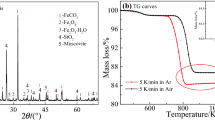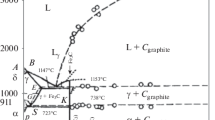Abstract
Three experiments were set up to evaluate conditions for the high-temperature decomposition of celadonite from a banded iron formation in an alumina-free system and identify its decomposition products. It was estimated that at 650 and 750 °C, with a NiNiO buffer and pressure of 3 kbar, celadonite completely decomposes and the decomposition products were tetraferribiotite, magnetite and quartz. Under more oxidizing conditions (hematite-magnetite buffer instead of NiNiO), ferrous potassium feldspar sanidine forms instead of magnetite. During the celadonite decomposition in oxidizing conditions more magnesian and aluminous tetraferribiotite, along with ferrous sanidine, are formed than at reducing conditions.










Similar content being viewed by others
References
Beukes N, Klein C (1990) Geochemistry and sedimentology of a facies transition from microbanded to granular iron-formation in the early proterozoic transvaal supergroup, South Africa. Precambrian Res 47:99–139. doi:10.1016/j.bbr.2011.03.031
Boles JR, Coombs DS (1975) Mineral reactions in zeolitic Triassic tuff, Hokonui Hills, New Zealand. Geol Soc Am Bull 86:163–173
Coombs DS (1954) The nature and alteration of some Triassic sediments from Southland, New Zealand. Trans R Soc N Z 82:65–109
Holland TJB, Redfern SAT (1997a) Unit cell refinement from powder diffraction data: the use of regression diagnostics. Miner Mag 61:65–77
Holland TJB, Redfern SAT (1997b) UNITCELL: a nonlinear least-squares program for cell-parameter refinement implementing regression and deletion diagnostics. J Appl Cryst 30:84
Landis CA (1974) Stratigraphy, lithology, structure, and metamorphism of Permian, Triassic, and Tertiary rocks between the Mararoa River and Mount Snowdon, western Southland, New Zealand. J R Soc N Z 4:229–251
Li G, Peacor DR, Coombs DS, Kawachi Y (1997) Solid solution in the celadonite family: the new minerals ferroceladonite, K2Fe2 2+Fe2 3+Si8O20(OH)4, and ferroaluminoceladonite, K2Fe2 2+Al2Si8O20(OH)4. Am Mineral 82:503–511
Miyano T, Beukes NJ (1997) Mineralogy and petrology of the contact metamorphosed amphibole asbestos-bearing Penge iron formation, Eastern Transvaal, South Africa. J Petrol 38:651–676
Miyano T, Klein C (1983) Conditions of riebeckite formation in the iron formation of the Dales Gorge Member, Hamersley Group, Western Australia. Am Mineral 68:517–529
Miyano T, Miyano S (1982) Ferri-annite from the Dales George Member iron-formations, Wittenoom area, Western Australia. Am Mineral 67:1179–1194
Nadezhina TN, Pushcharovskiy DY, Taroev VK, Tauson VI, Bychkov AM (1993) Crystal structure of ferrialuminosilicate low sanidine. Kristallografiya 38(6):77–82 (in Russian)
Savko КA, Poskryakova MV (2003) Riebeckite–aegirine–celadonite BIF at the Mikhailovskoe Iron Deposit of the Kursk Magnetic Anomaly: phase equilibria and metamorphic conditions. Petrology 11(5):426–443
Trendall AF, Blockley JG (1970) The iron formation of the Precambrian Hamersley Group, Western Australia with special reference to the associated crocidolite. Western Australia, Geological Survey of Western Australia
Veres GI, Merenkova TB, Ostrovsky IA (1955) Artificial pure ferrous hydroxyl mica. Dokl Akad Nauk SSSR 101(1):147–150 (in Russian)
Wise WS, Eugster HP (1964) Celadonite: synthesis, thermal stability and occurrence. Am Mineral 49:1031–1083
Wones DR (1963) Phase equilibria of “ferriannite”, KFe +23 Fe+3Si3O10(OH)2. Am J Sci 261:581–596
Author information
Authors and Affiliations
Corresponding author
Rights and permissions
About this article
Cite this article
Savko, K.A., Piliugin, S.M. & Bazikov, N.S. Experimental data for high-temperature decomposition of natural celadonite from banded iron formation. Chin. J. Geochem. 34, 507–514 (2015). https://doi.org/10.1007/s11631-015-0066-2
Received:
Revised:
Accepted:
Published:
Issue Date:
DOI: https://doi.org/10.1007/s11631-015-0066-2




